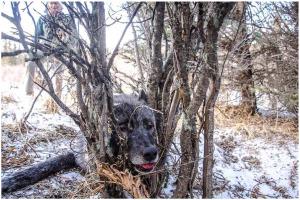Global Ecology and Conservation ( IF 3.5 ) Pub Date : 2020-09-28 , DOI: 10.1016/j.gecco.2020.e01293 Mark Hebblewhite , Jesse Whittington

|
Large carnivores are important ecological drivers of ecosystem dynamics when they occur at ecologically effective densities. They are also challenging to conserve, especially in transboundary settings such as along borders of national parks. Here, we tested for effects of transboundary movements on survival of 72 radiocollared gray wolves from 1987 to 2018 in and adjacent to Banff National Park, Canada. We fit Bayesian counting-process survival models to known-fate radiotelemetry data and tested for the influence of intrinsic covariates such as sex and age, time, and movements outside of protected area on survival of wolves. We also estimated cause-specific mortality. Non-parametric survival was 0.733 (95% CI 0.622–0.816), and the top Bayesian survival model indicated that wolves outside the park had much lower annual survival rates (0.44, 95% BCI = 0.24–0.65) compared to wolves inside the park (0.84, 95% BCI = 0.73–0.91). The cumulative risk of mortality was on average 6.7 times higher (odds ratio 95% BCI = 2.2–21.4) for wolves outside the park, peaking during the winter hunting and trapping seasons. We found weak evidence for declining survival over time, opposite to patterns predicted by density-dependence. Bayesian cause-specific mortality indicated that the top three sources of mortality were trapping (rate = 0.080, 36% of mortality), followed by hunting (0.053, 18%), and highway (0.046, 18%) mortality. Surprisingly, we found no intraspecific mortality, and low dispersal from Banff National Park. This demographic profile is akin to other exploited populations across North America. While we were unable to combine survival rates with reproduction to estimate population trends, the overall mortality rates within our study area are consistent with a stable wolf population. Nonetheless, the long-term stability and ecological effectiveness of wolves likely differed inside and outside of protected areas, which highlights a challenge with managing transboundary carnivores exposed to different management regimes.
中文翻译:

狼无国界:班夫国家公园的狼跨界生存了三十多年
当大型食肉动物以生态有效密度发生时,它们是生态系统动力学的重要生态驱动力。它们的保护也极具挑战性,尤其是在诸如国家公园边界之类的跨界环境中。在这里,我们测试了越境转移对1987年至2018年在加拿大班夫国家公园及其附近的72头放射性领灰狼存活率的影响。我们将贝叶斯计数过程生存模型拟合到已知命运的无线电遥测数据,并测试了内在协变量(如性别和年龄,时间以及保护区外移动对狼生存)的影响。我们还估计了特定原因的死亡率。非参数生存率为0.733(95%CI 0.622–0.816),顶级贝叶斯生存模型表明公园外的狼的年生存率低得多(0.44,与公园内的狼相比(95%BCI = 0.24–0.65)(0.84,95%BCI = 0.73–0.91)。公园外的狼的平均累积死亡风险平均高6.7倍(优势比95%BCI = 2.2–21.4),在冬季狩猎和诱捕季节达到峰值。我们发现,随着时间推移,存活率下降的证据不充分,这与密度依赖性预测的模式相反。贝叶斯特定原因的死亡率表明,死亡率的前三位来源是诱捕(比率= 0.080,占死亡率的36%),其次是狩猎(0.053,占18%)和公路(0.046,18%)死亡率。出乎意料的是,我们没有发现种内死亡率,而且班夫国家公园的散布率也很低。该人口概况类似于北美其他被剥削的人口。尽管我们无法将生存率与繁殖率结合起来估算人口趋势,我们研究区域内的总体死亡率与稳定的狼群一致。尽管如此,在保护区内外,狼的长期稳定性和生态有效性可能会有所不同,这凸显了管理暴露于不同管理制度的跨界食肉动物的挑战。











































 京公网安备 11010802027423号
京公网安备 11010802027423号